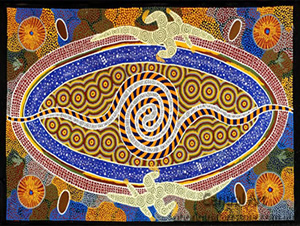Art Encyclopedia - Aboriginal Art
Art information > Art Encyclopedia > A > Aboriginal Art
Aboriginal Art
Aboriginal Art is art produced by indigenous Australians called Aborigines and the art is based on
their traditional culture. Aboriginal Art covers a wide variety of mediums including painting, wood
carving, sculpture, ceremonial clothing and artistic embellishments found on weapons and tools. In
Aboriginal culture art is used to mark territory, record history and tell stories.
 Paints for traditional Aboriginal paintings were often made from water or spittle
mixed with ochre and other rock pigments. The paintings were performed on persons, rock walls or bark
with tools such as primitive brushes, sticks and fingers. Sometimes paint were applied by spraying
paint from the mouth.
Paints for traditional Aboriginal paintings were often made from water or spittle
mixed with ochre and other rock pigments. The paintings were performed on persons, rock walls or bark
with tools such as primitive brushes, sticks and fingers. Sometimes paint were applied by spraying
paint from the mouth.
The imagery of the Aboriginal culture, as can be seen in many of the sacred sites, rock and cave
paintings, used few colours as they were often made from what was available locally. Some colours were
mined from ‘ochre pits’, being used for both painting and ceremonies, with ochre also
traded between clans and at one time could only be collected by specific men within the clan. Other
pigments were made from clay, wood ash or animal blood. There were variations in the symbolic
representation of some rock art and paintings, depending on the tribe or region of Australia that you
belong to, which is still evident today in the modern art work of Aboriginal artists. The dotted
motifs of much of today's Aboriginal modern design work has become the trademark of the contemporary
Aboriginal Art movement. Its iconic status developed from a culture stretching back into the history
of an ancient land, evolving and weaving into desert dreamtime stories.
Certain symbols within the Aboriginal modern art movement retain the same meaning across regions,
although the meaning of the same symbols may change within the context of the whole painting. When
viewed in monochrome other symbols can look similar, such as the circles within circles, sometimes
depicted on their own, sparsely or in clustered groups. When this symbol is used and depending on the
Aboriginal tribe you belong to, it can vary in meaning from campfire, tree, hill, digging hole,
waterhole or spring. Use of the symbol can be clarified further by the use of colour, such as water
being depicted in blue or black.
While the most commonly used symbols are relatively simple, they can be used in elaborate
combinations to tell more complex stories. For example, a Water Dreaming painting might show a U
shaped symbol for a man, sitting next to a circle or concentric circles representing a waterhole, and
spiral lines showing running water. The painter is telling the story of the power of the water man to
invoke rain. Further symbols will add to the depth of meaning. Today artists often refer to the
'outside' story which they provide for the general public while the painting retains an 'inside' story
accessible only to those with the appropriate level of knowledge.
Many paintings by Aboriginal artists, such as those that represent a 'dreamtime story', are shown
from an aerial perspective. The narrative follows the lie of the land, as created by ancestral beings
in their journey or during creation. The modern day rendition is a reinterpretation of songs,
ceremonies, rock art and body art that was the norm for many thousands of years.
Whatever the meaning, interpretations of the icons should be taken in context of the entire painting,
the region from which the artist originates, the story behind the painting, the style of the painting,
with additional clues being the colours used in some of the more modern works, such as blue circles
signifying water.
